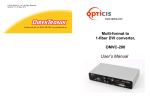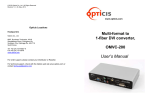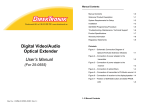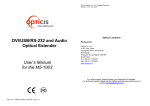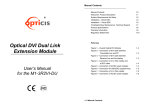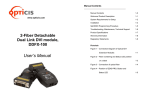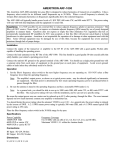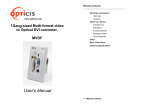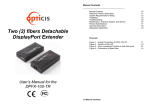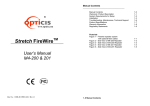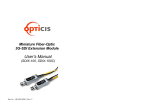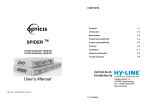Download User`s Manual
Transcript
Manual Contents __________________________________________ www.opticis.com DVI to 1-fiber DVI converter, DVDF-200 Manual Contents 1-0 Welcome! Product Description 1-1 System Requirements for Setup 1-2 Installation 1-3 Self-EDID Programming Procedure 1-5 Troubleshooting, Maintenance, Technical Support 1-6 Product Specifications 1-7 Warranty Information 1-8 Regulatory Statements 1-9 Pictorials Figure 1 – Connection Diagram of DVDF-200 User’s Manual Doc No. : OC-D130903 / Rev1.1 1- 0 Manual Contents 1-4 Welcome! Congratulations on your purchase of the DVI to 1-fiber DVI converter, DVDF200. This manual contains information that will assist you in installing and operating the product. System Requirements for Setup Hardware requirements You have to have a DVI graphic controller or card having a DVI port in your PC, SUN or Mac systems. It should support the maximum graphic resolution feature of displays to be connected. No special requirements for memory size, CPU speed and chipsets, if you’ve already properly installed your DVI graphic controllers or cards. Product Description The DVDF-200, DVI to 1-fiber DVI converter receives DVI up to WUXGA (1920x1200), 60Hz signal and converts to optical signal and transmits up to transmits 500 meters (1640feet) over one (1) SC multi-mode fibers. OPTICIS 1-fiber DVI receiver, DVFX-100-R is used as a pair to recover 1 fiber DVI to electrical DVI. The EDID (Extended Display Identification Data) in a display can be read and restored by just connecting once transmitter to the display. This Self-EDID programming feature makes the installation of DVDF-200 more easy and flexile at any variable resolution display systems. For your convenience, WUXGA EDID had been stored before shipment as a default. Software requirements No special restrictions, if you’ve already properly installed your DVI graphic controller in your OS. Shipping Group DVDF-200, DVI to 1-fiber DVI converter: One (1) unit AC/DC power adapter: One (1) unit of +5V, 3A (Locking type) User’s Manual Option Product: Mounting bracket 1-1 Welcome, Product Description 1-2 System Requirements for Setup Installation Important: Please keep the installation procedure below. Improper or no operation may result if the start-up sequence is not correctly followed. Note1: The maximum extension length by multi-mode fiber is 500 meters. Note2: Be recommended NOT to use any intermediate cable or adapter in between to avoid undesirable performance degradation. Step 1 Carefully unpack the contents of the shipping group. Step 2 DVDF-200 Plug and fasten the 5V power adapters to the +5V DC jack on the rear side of converter. Ensure the Power LED ON (Blue). On e Up to (1) Op tica lF WU ibe r XG A Step 3 Please, check if the maximum resolution of the display is WUXGA (1920x1200). Otherwise, follow the instructions for Self-EDID Programming Procedure on page 1-5. DVFX-100 Rx DVI Source Step 4 Connect the DVI source to DVI IN port over DVI cable. If the DVI source is active, status LED (Blue) will be turned on. Local DVI Display Remote DVI Display Step 5 Connect the OPTICAL OUT to 1-fibe DVI receiver, DVFX-100-R over multimode SC-SC optical fiber. Figure 1 – Connection Diagram of DVDF-200 Step 6 Plug DVFX-100-R to DVI input port of display. Step 7 If you need on-site monitoring, connect DVI OUT on the front side to DVI input port of local monitor over DVI cable. 1-3 Installation 1-4 Installation Self-EDID Programming Procedure The graphic source equipment generally requires display information (EDID). It contains resolution and timing information of the display. DVDF-200 supports Self-EDID programming. It is the procedure that reads the EDID from the display and stores it in the EEPROM of the converter. We highly recommend do SelfEDID once when you install your system with DVDF-200 for the first time. Follow the steps below to do it correctly. Note1: If you know that EDID is not required by the user’s DVI source, Self-EDID programming is not necessary. Note2: The default EDID in factory ship-out is programmed in the VESA standard of WUXGA (1920x1200), 60Hz. Troubleshooting The display shows only black screen. - Ensure that all plugs and jacks used by external power supplies (both Opticis and others) are firmly connected. Ensure that the Power and status LED ON. - Ensure that the video ports are firmly plugged in to the PC and display. - Ensure that the converter and receiver modules plugged correctly to the PC and display, respectively. - Check if the PC and display are powered on and properly booted. Step 1 Screen is distorted or displays noises. Connect 5V power adapter to turn DVDF-200. - Check if the graphic resolution is properly set. Go to the display properties of Windows and tap the settings. Step 2 Power LED (Blue) will be turned ON. Step 3 Push the EDID button on the rear side of converter with a narrow pin. Then, status LED (Blue) will blink 3 times and turned ON. Step 4 Connect the DVI OUT port on the front side of converter to the DVI input port of display over DVI cable. Then the status LED will begin to blink rapidly. It indicates reading the EDID from the display and storing it in the EEPROM. After 8~10 sec blinking, the status LED will be turned OFF and it indicates completion of all procedure. - Ensure that the resolution sets less than WUXGA (1920x1200) at 60Hz refresh ratio. - Reset the system. Disconnect and reconnect the optical fiber or 5V power adapters. Maintenance No special maintenance is required for the converter and power adapters. Ensure that the converter and power adapters are stored or used in a benign environment free from liquid or dirt contamination. There are no user serviceable parts. Refer all service and repair issues to Opticis. Step 5 Disconnect the converter from the display. Technical Support and Service For commercial or general product support, contact your reseller. For technical service, contact Opticis by email [email protected] or visit its website at www.opticis.com 1-6 Troubleshooting, Maintenance, Technical Support 1-5 Self-EDID Programming Procedure Product Specifications Warranty Information 1 (One) Year Warranty DVDF-200, DVI to 1-fiber DVI converter Compliance with DVI standard: Supports DVI1.0, fully implemented by fiber-optic communication and DDC2B by virtual DDC. Extension limit: 500 meters (1640 feet) for WUXGA (1920x1200) , 60Hz refresh rate. Graphic transmission bandwidth: Supports up to WUXGA, 60Hz, or 1.65Gbps bandwidth per graphic channel. Supporting resolution (Based on DVI input) HDTV) 480p, 720p, 1080p VESA) VGA, SVGA, XGA, WXGA, SXGA, WXGA+, UXGA, WSXGA+, WUXGA. Fiber-optic connection: DVDF-200 has one (1) SC receptacles so as to be connected with one (1) SC multi-mode fiber, having 62.5 (50) / 125m core. DDC connection: Virtual DDC by Self-EDID programming. Dimensions (WDH): 104 x 112 x 28mm Environmental Specifications Operating temperature: 0°C to 50°C Storage temperature: - 30°C to 70°C Humidity: 0% to 85% AC/DC Power Adapter Power Input: AC 100-240V, 50/60Hz 0.1A Power Output: +5 V, 3A SMPS DC-power Adapter Cord DC Jack: Core is 5 V and outer is GND. Opticis warrants this DVDF-200 to be free from defects in workmanship and materials, under normal use and service, for a period of one (1) year from the date of purchase from Opticis or its authorized resellers. If a product does not work as warranted during the applicable warranty period, Opticis shall, at its option and expense, repair the defective product or part, d eliver to customer an equivalent product or part to replace the defective item or refund to customer the purchase price paid for the defective product. All products that are replaced will become the property of Opticis. Replacement products may be new or reconditioned. Any replaced or repaired product or part has a ninety (90) day warranty or the reminder of the initial warranty period, whichever is longer. Opticis shall not be responsible for any software, firmware, information, or me mory data of customer contained in, stored on, or integrated with any product s returned to Opticis for repair under warranty or not. Warranty Limitation and Exclusion Opticis shall have no further obligation under the foregoing limited warranty if the product has been damaged due to abuse, misuse, neglect, accident, unusual physical or electrical stress, unauthorized modifications, tampering, alterations, or service other than by Opticis or its authorized agents, causes other than from ordinary use or failure to properly use the product in the application for which said product is intended. Dispose of Old Electrical & Electronic Equipment (Applicable in the European Union and other European countries with separate systems) This symbol on the product or on its packaging indicates that this product shall not be treated as household waste. Instead it shall be handed over to the applicable collection point for the recycling of electrical and electronic equipment. By ensuring this product is disposed of correctly, you will help prevent potential negative consequences for the environment and human health, which could otherwise be caused by inappropriate waste handling of this product. The recycling of materials will help to conserve natural resources. For more detailed information about recycling of this product, please contact your local city office, your household waste disposal service or the shop where you purchased the product. 1-7 Product Specifications 1-8 Warranty Information Regulatory Statements This device complies with part 15 of FCC Rules. Operation is subject to the following two conditions: (1) this device may not cause harmful interference, and (2) this device must accept any interference received, including interference that may cause undesired operation. This equipment has been tested and found to comply with the limits for a Class B digital device, pursuant to part 15 and 2 of FCC Rules, EN 55022/55024/61000-3 for CE certification. These limits are designed to provide reasonable protection against harmful interference when the equipment is operated in a residential installation. This equipment generates, uses, and can radiate radio frequency energy and. if not installed and used in accordance with the instruction guide, may cause harmful interference to radio communications. However, there is no guarantee that interference will not occur in a particular installation. If this equipment does cause harmful interference to radio or television reception, which can be determined by turning the equipment off and on, the user is encouraged to try to correct the interference by one or more of the following measures: Re-orient or relocate the receiving antenna. Increase the separation between the equipment and the receiver. Connect the equipment into an outlet on a circuit different from that to which the receiver is connected. Consult a service representative for help. Properly shielded and grounded cables and connectors must be used in order to comply with FCC/CE emission limits. Changes or modifications not expressly approved by the party responsible for compliance could void the user s authority to operate the equipment. 1-9 Regulatory Statements © 2013 Opticis Co., Ltd. All Rights Reserved Revision 1.1 3, Sep, 2013 Opticis Locations Headquarters Opticis Co., Ltd. # 16Fl, Kins Tower 8 Sungnam-daero, 331 beon-gil, Bundang-gu, Seongnam-si, Gyunggi-do, 463-844 South Korea Te l: +82 (31) 719-8033 Fax: +82 (31) 719-8032 www.opticis.com For order support, please contact your Distributor or Reseller. For technical support, check with the Opticis web site www.opticis.com or contact [email protected]







